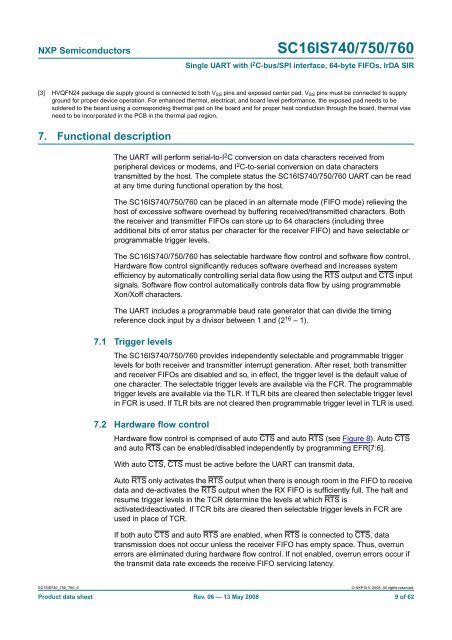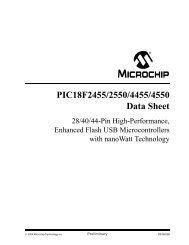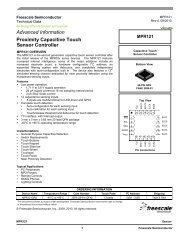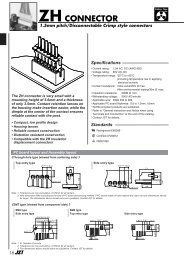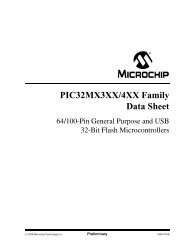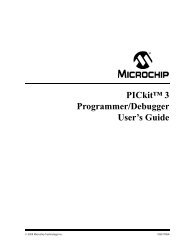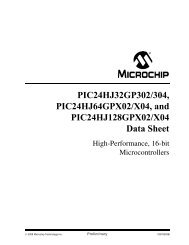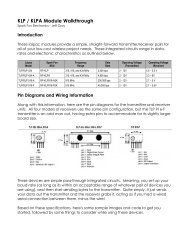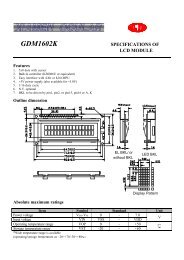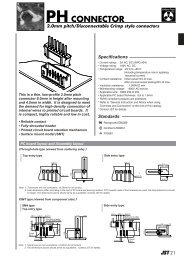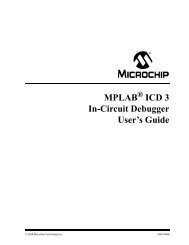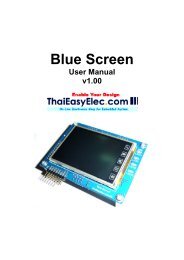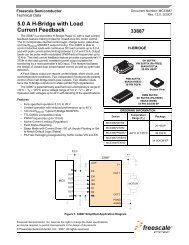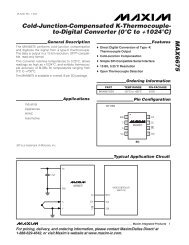SC16IS740/750/760 Single UART with I2C-bus/SPI interface, 64 ...
SC16IS740/750/760 Single UART with I2C-bus/SPI interface, 64 ...
SC16IS740/750/760 Single UART with I2C-bus/SPI interface, 64 ...
You also want an ePaper? Increase the reach of your titles
YUMPU automatically turns print PDFs into web optimized ePapers that Google loves.
NXP Semiconductors<br />
<strong>SC16IS740</strong>/<strong>750</strong>/<strong>760</strong><br />
<strong>Single</strong> <strong>UART</strong> <strong>with</strong> I 2 C-<strong>bus</strong>/<strong>SPI</strong> <strong>interface</strong>, <strong>64</strong>-byte FIFOs, IrDA SIR<br />
[3] HVQFN24 package die supply ground is connected to both V SS pins and exposed center pad. V SS pins must be connected to supply<br />
ground for proper device operation. For enhanced thermal, electrical, and board level performance, the exposed pad needs to be<br />
soldered to the board using a corresponding thermal pad on the board and for proper heat conduction through the board, thermal vias<br />
need to be incorporated in the PCB in the thermal pad region.<br />
7. Functional description<br />
The <strong>UART</strong> will perform serial-to-I 2 C conversion on data characters received from<br />
peripheral devices or modems, and I 2 C-to-serial conversion on data characters<br />
transmitted by the host. The complete status the <strong>SC16IS740</strong>/<strong>750</strong>/<strong>760</strong> <strong>UART</strong> can be read<br />
at any time during functional operation by the host.<br />
The <strong>SC16IS740</strong>/<strong>750</strong>/<strong>760</strong> can be placed in an alternate mode (FIFO mode) relieving the<br />
host of excessive software overhead by buffering received/transmitted characters. Both<br />
the receiver and transmitter FIFOs can store up to <strong>64</strong> characters (including three<br />
additional bits of error status per character for the receiver FIFO) and have selectable or<br />
programmable trigger levels.<br />
The <strong>SC16IS740</strong>/<strong>750</strong>/<strong>760</strong> has selectable hardware flow control and software flow control.<br />
Hardware flow control significantly reduces software overhead and increases system<br />
efficiency by automatically controlling serial data flow using the RTS output and CTS input<br />
signals. Software flow control automatically controls data flow by using programmable<br />
Xon/Xoff characters.<br />
The <strong>UART</strong> includes a programmable baud rate generator that can divide the timing<br />
reference clock input by a divisor between 1 and (2 16 – 1).<br />
7.1 Trigger levels<br />
The <strong>SC16IS740</strong>/<strong>750</strong>/<strong>760</strong> provides independently selectable and programmable trigger<br />
levels for both receiver and transmitter interrupt generation. After reset, both transmitter<br />
and receiver FIFOs are disabled and so, in effect, the trigger level is the default value of<br />
one character. The selectable trigger levels are available via the FCR. The programmable<br />
trigger levels are available via the TLR. If TLR bits are cleared then selectable trigger level<br />
in FCR is used. If TLR bits are not cleared then programmable trigger level in TLR is used.<br />
7.2 Hardware flow control<br />
Hardware flow control is comprised of auto CTS and auto RTS (see Figure 8). Auto CTS<br />
and auto RTS can be enabled/disabled independently by programming EFR[7:6].<br />
With auto CTS, CTS must be active before the <strong>UART</strong> can transmit data.<br />
Auto RTS only activates the RTS output when there is enough room in the FIFO to receive<br />
data and de-activates the RTS output when the RX FIFO is sufficiently full. The halt and<br />
resume trigger levels in the TCR determine the levels at which RTS is<br />
activated/deactivated. If TCR bits are cleared then selectable trigger levels in FCR are<br />
used in place of TCR.<br />
If both auto CTS and auto RTS are enabled, when RTS is connected to CTS, data<br />
transmission does not occur unless the receiver FIFO has empty space. Thus, overrun<br />
errors are eliminated during hardware flow control. If not enabled, overrun errors occur if<br />
the transmit data rate exceeds the receive FIFO servicing latency.<br />
<strong>SC16IS740</strong>_<strong>750</strong>_<strong>760</strong>_6<br />
© NXP B.V. 2008. All rights reserved.<br />
Product data sheet Rev. 06 — 13 May 2008 9 of 62


